
Air-conditioning (aircon) removes heat energy and water vapour keep a room's temperature and humidity at comfortable levels. Most aircon systems use the same heat pump...
Air-conditioning is a major running cost of many commercial buildings, but it's needed to keep the internal temperature comfortable. Here we discuss some of the ways in which building management, selective use of new technologies and smart building controls can cut the aircon costs to a minimum.
Many commercial buildings in Britain were built before energy efficiency was as important a design consideration as it is now, so they depend on building services - such as heating and aircon - rather than design to keep the temperature comfortable. We've discussed what aircon does and how it does it elsewhere but the practical problem facing a building manager is how to keep the staff comfortable without the overhead costs getting too uncomfortable.
 A Carbon Trust report on aircon [PDF] estimates that it amounts to around 30% of the energy costs of some offices, but also suggests some ways to keep the costs from spiralling too far out of control. The Building Research Establishment (BRE) has its own list of interventions [PDF] along with the likely savings from each of them.
A Carbon Trust report on aircon [PDF] estimates that it amounts to around 30% of the energy costs of some offices, but also suggests some ways to keep the costs from spiralling too far out of control. The Building Research Establishment (BRE) has its own list of interventions [PDF] along with the likely savings from each of them.
We've incorporated the Carbon Trust and BRE's ideas on cost cutting with some of our own here:
The first thing to look at isn't the aircon itself, but the source of the heat that it's gulping down electricity to pump out of the building. We can't turn down the sun on a hot day, but we can look at the internal gains: the things that generate heat inside a building. Making sure that the lagging on the hot water pipes isn't falling apart is a good start.
It's also worth making sure that your lighting system is the most efficient available. Today's lighting systems are much more efficient than those of 20 years ago because they don't waste energy by turning it into heat. That means less electricity is needed to produce the same amount of light and less heat energy for the aircon to deal with. Some 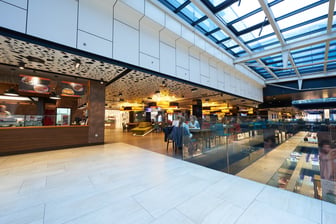 offices are still using those older systems, so it may be worth calculating how long it would take an upgrade to pay for itself.
offices are still using those older systems, so it may be worth calculating how long it would take an upgrade to pay for itself.
Among inefficient lights, the worst offenders are display lights. Partly for that reason, a BRE study on energy used for aircon [PDF] that found that aircon costs tend to be higher in retail than in office buildings.
Completely replacing an office's 30-year-old lighting system carries a substantial cost in both money and disruption, and there's no point in having a shop window display that doesn't invite passers-by to look into it. However, it's always worth sparing a thought for whether the lighting is as efficient as it can be within the constraints you have to work with.
A common feature of all aircon systems is the fan, and where there's a fan, there's a dust filter. That's true whether it's a single unit aircon recirculating air around a room or a large building's air handling system that blows air through metres of ductwork. Sooner or later, those filters will get clogged and the fan will have to work harder to maintain the same airspeed through the ducts. Filters need a regular clean to go on working at full efficiency.
Another management problem is the wear and tear on the ductwork itself. The BRE aircon study estimated that a building's ductwork should last for 40 years, but only if it's properly maintained. Left to its own devices, the ductwork will develop leaks that force the fans to work harder to keep the air flowing, and may deteriorate to the extent that it 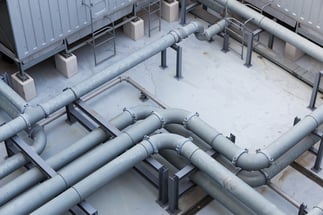 needs replacing earlier than it needs to be.
needs replacing earlier than it needs to be.
The same report found that aircon units last for over 20 years but like the ductwork, they need regular maintenance to perform at their best. The most likely problem is a leak in the pipes carrying the refrigerant. An aircon unit's refrigeration cycle works by varying the pressure of the refrigerant fluid. That means the system needs to be sealed or the expensive aircon unit is demoted to a rather inefficient fan.
If a building is large enough to have its own maintenance staff, someone might be tasked to clean the filters and check for leaks on a regular schedule. Alternatively, a maintenance firm might be contracted to do it every few months. However it's managed, it does need to be done for the aircon to work properly.
Jimmy takes his seat in the open-plan office, already sweating from the bus that brought him to work. He knows the day is only going to get hotter so he switches on the aircon. He hasn't noticed that at the other end of the office, Jenny has come in feeling just as hot and bothered and opened a window.
They're in the midst of a heatwave so the outside air temperature has climbed to the high twenties by eleven o'clock, and both Jimmy and Jenny are too intent on meeting their deadlines to notice that the aircon's trying to cool down the hot air it's pulling in through the open window. They go home at five o'clock with the feeling that they might have got more done if they hadn't sweated so much, leaving Jerry in the next office because his deadline's so imminent that he'll be lucky to get home before midnight.
As the sun goes down and the outside temperature falls, Jerry starts feeling cold. He doesn't know about the open window and the aircon whirring away on the other side of a thin wall. He's too intent on his deadline to go and check. He just wants to finish and go home, and to be reasonably comfortable in the meantime. So he turns the heating on.
It's a situation that's difficult to avoid in a building used by many different people, none of whom have building management in their job description. Even a full-time building manager will have their work cut out to keep Jimmy, Jenny and Jerry from inadvertently conspiring to add zeroes to the energy bill.
Building management could be made a lot easier using smart controls that take control of the aircon, heating and ventilation - which includes motorising the window that Jenny keeps fiddling with. Once the room temperature is set, the building control system finds the most energy efficient way to keep the room at that temperature while simultaneously monitoring the air quality and controlling the ventilation.
A management system can also help with maintenance. It monitors the energy used by the aircon units, and can flag up any unit that starts needing more energy to achieve the same temperature: time to clean the filters and check for refrigerant leaks.
One drawback of an aircon unit's 20-year lifespan is that it's long enough for the technology to move forward and bring more efficient systems on to the market while the old one is still in the prime of its projected lifespan. Older systems often don't get replaced until they finally expire, or at least until the costs of fixing the constant leaks prompt a management decision to put them out of their misery.
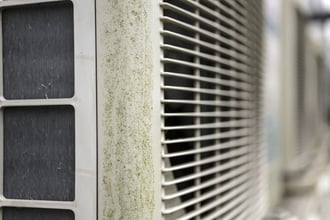 When looking at how efficient an aircon system is, the figure that matters is the seasonal energy efficiency ratio (SEER): cooling output divided by energy input. Put simply, the higher the SEER, the less electricity you need to achieve the same level of cooling. To get an idea of what's counted as a good SEER, it's worth looking across the Atlantic. Aircon is an essential building service in the subtropical southern part of the USA rather than the afterthought it often is in the UK. American regulations show the rapid improvement in aircon technology: the minimum SEER was 10 in 1992, which was raised to 13 in 2006 and 14 in some regions in 2015.
When looking at how efficient an aircon system is, the figure that matters is the seasonal energy efficiency ratio (SEER): cooling output divided by energy input. Put simply, the higher the SEER, the less electricity you need to achieve the same level of cooling. To get an idea of what's counted as a good SEER, it's worth looking across the Atlantic. Aircon is an essential building service in the subtropical southern part of the USA rather than the afterthought it often is in the UK. American regulations show the rapid improvement in aircon technology: the minimum SEER was 10 in 1992, which was raised to 13 in 2006 and 14 in some regions in 2015.
The upshot is that it may be worth replacing older aircon units before their last gasp, especially as a unit's SEER tends to drop with age while its maintenance costs mount up. The cost of replacing a system may not be trivial, but it may be worth calculating how long it would take to pay for itself.
We need the aircon most when the sun is at its most fierce, which opens up an opportunity to draw energy from the sun itself rather than paying for it. Photovoltaic cells on a building's exterior can power the building's aircon using the same energy source that the aircon is needed to counter.
It's that first day back to work after the Christmas holidays. Jimmy, Jenny and Jerry all come into the office with that back-to-school feeling, which isn't helped by the short, gloomy days or by their pact to sign up for Dry January which they're already beginning to regret. The last thing they need is to come to work in an office that's as cold as the buses they just shivered their way to work on.
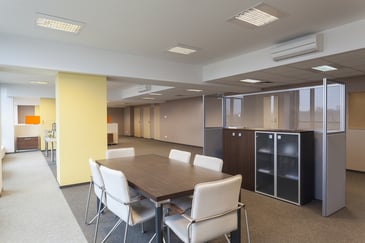 After a few days of standing empty, the office has chilled to the outside temperature and the building manager has only just turned on the central heating, which will take until lunchtime to warm the place up. The good news is that after the management worked out how many times the heating and aircon were on at the same time last summer, they've replaced the old aircon units with air-to-air heat pumps.
After a few days of standing empty, the office has chilled to the outside temperature and the building manager has only just turned on the central heating, which will take until lunchtime to warm the place up. The good news is that after the management worked out how many times the heating and aircon were on at the same time last summer, they've replaced the old aircon units with air-to-air heat pumps.
An aircon unit is a heat pump that extracts heat energy from inside a building and deposits it outside. Older aircon units are one-way systems but the new generation of air-to-air heat pumps can reverse the direction in which they pump heat energy: if the interior of a building is uncomfortably cold, they can function as fan heaters.
An air-to-air heat pump can heat the air in the room very quickly, which is something that Jimmy, Jenny and Jerry are very grateful for as they find they can take off their coats and scarves before they've finished the first of several cups of coffee they'll each need to get through the day. If they were in a modern office building, they wouldn't need the central heating at all. The building fabric would be so well insulated that the air-to-air heat pumps would have given them all the heat they'd need. As their firm is based in a drafty 1960s monstrosity that needs constant heating, it's more efficient to use the air-to-air heat pumps to warm the place up quickly and then have them switch off once the central  heating has creaked and groaned into life.
heating has creaked and groaned into life.
Come April, when Jimmy, Jenny and Jerry can go for an after-work beer with a clear conscience, the air-to-air heat pumps may still need to run as heaters on a Monday morning but the combination of sunlight, computers and people metabolising will have them running as aircon units for most of the time. All the building manager will need to do is set the thermostat, and even Jimmy and Jerry won't be able to use one to heat and cool the building at the same time.
Whatever a building is used for, it will nearly always have one place where it needs heat energy: the hot water tank. Water has a high thermal capacity, which means it needs a lot of energy to heat it up, and it needs to be stored at above 60°C (140°C) to stop bacteria from growing in it. With that in mind, the heat energy that's making everyone sweat starts looking less like a nuisance and more like a resource in the wrong place. Hot air can be ducted out of the rooms with people in them and through a micro-heat pump that extracts it to heat up the building's water supply. The cooler air can then be ducted back into the rooms to cool down the people.
Rather than having one system consuming energy to cool the air and another consuming more energy to heat the water, a heat pump water heater does both at the same time.
Here we take a look into the future, at a system that is not yet in widespread use.
The outside air temperature can change dramatically between day and night, let alone between winter and summer. A few metres under the ground, the temperature doesn't 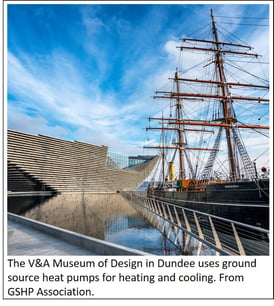 vary much from 10°C (50°F) from July to February in most of Britain. It's a fact that's been used in heating water [PDF] for some time: during the winter, cold water is pumped into the ground and when it comes back up at 10°C, it's passed through a heat pump that extracts the heat energy for heating either the building or its hot water.
vary much from 10°C (50°F) from July to February in most of Britain. It's a fact that's been used in heating water [PDF] for some time: during the winter, cold water is pumped into the ground and when it comes back up at 10°C, it's passed through a heat pump that extracts the heat energy for heating either the building or its hot water.
Using similar technology to the reversible air-to-air heat pump, a ground-source heat pump can reverse the process in the summer, burying the heat under the ground using the same system that powers heating in the winter. A constraint of GSHC is that it needs access to enough outdoor space to bury the pipes for the heat exchange.
GSHC still has a way to go before it's an established technology, but there are a number of case studies that list both modern and older buildings in which use it. We should have enough information to evaluate GSHC in the near future.
If you have any questions about air conditioning, please ask us using the form below and we'll be happy to answer.